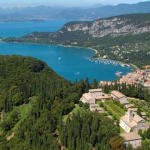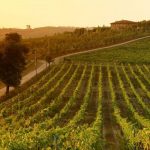
26 Feb 2014 Etna Vignerons: Mick Hucknall’s winemaking estate in Sicily
Wine is one of Italy’s most authoritative ambassadors around the world.
Through taste, touch and smell, wine transmits the beauty and harmony of the territory in which it was produced. Like music. It is no coincidence that many internationally famous singers – Peter Gabriel, Sting, Mick Hucknall and Jim Kerr, to name just a few – have chosen to make wine in Italy, looking for the authenticity that only direct contact with nature and tradition can provide.
In 2001, Mick Hucknall, lead singer of Simply Red, set up “Il Cantante” winemaking estate in Sicily, on two slopes of Mount Etna: looking out to sea from the municipality of Sant’Alfio in the east; and, to the north, between Castiglione di Sicilia and Randazzo.
“I am nearly always there at harvest time because I love this magical phase of wine production that always turns into a party on Etna. Those are the days when I am actively involved. Often it is very tiring, but the environment is truly spectacular, filled with perfumes, colors and humanity, which I find extraordinary. Those moments fill me with vitality”. 
This is how Hucknall describes his new activity. We learn this from Salvo Foti, an enologist and agronomist, the expert to whom the singer turned in order to start producing wine. Foti explains that Mount Etna played a crucial role in Hucknall’s choice as he was immediately attracted by the volcano:
“Mick visited Etna with his friend who owns a “palmento” (a traditional winery of the Etna area) and a vineyard that had more or less been abandoned. He immediately started thinking of starting to make wine again in his friend’s “palmento” and to purchase some vineyards in order to produce Etna wines that would be an expression of the volcano, whilst respecting local traditions and the territory.
Etna is like the “center of the universe”, a kind of North in the South. Here you find a heady mixture of cold, snow, ice, the influence of the sea, strong thermal excursions and, above all, the power of this primordial volcanic soil that emanates a great energy”.
It was here that, in 1435 (“before the discovery of America” as Foti points out), that “La Maestranza dei Vigneri” was set up, an association whose purpose was to train wine makers, passing on the knowledge and experience gained by the peasants who made wine on Etna to future generations.
“First you cultivate the men, then the wine”, says Foti, who set himself the same goal in 1999 when he re-established the “Maestranza” by creating a consortium of winemaking farms with the same name.
There are seven farms, located in the most important winemaking areas of Sicily and in areas of particular beauty in terms of landscape and culture: on the islands of Lipari and Pantelleria, on Mount Etna, the Calatino area, more precisely the woods of Santo Pietro, the Ragusa area and the territory of Noto and Vendicari, a particularly beautiful scenic area.
“The owners of the various winemaking farms are businessmen, farmers, professionals and artists, Sicilian and non-Sicilian, who have chosen to follow the philosophy of the “Vigneri”: to produce wine whilst maximizing and preserving the territory”, Foti continues.
 “The most ancient winemaking tradition of Sicily and Etna, in particular, requires the main work to be carried out in the vineyard, plant by plant, adopting the “Alberello” or head-trained bush pruning method, a viticultural system used for around 2,000 years which it is impossible to mechanize”.
“The most ancient winemaking tradition of Sicily and Etna, in particular, requires the main work to be carried out in the vineyard, plant by plant, adopting the “Alberello” or head-trained bush pruning method, a viticultural system used for around 2,000 years which it is impossible to mechanize”.
In fact, the symbol of the “Vigneri”, featured on the bottles, is that of a head-trained “alberello” vine after pruning, a symbol that, like the “Maestranza”, dates back to 1435.
“A vine that is grown in this manner will be in such harmony with its environment that it will provide excellent grapes for producing wine without the need for chemicals. This harmony is also expressed esthetically through the construction or restoration of dry walled terraces, and the manner in which the plants are cultivated,” concludes Foti.
“To this we should add the humanity of our “vignerons”, who are content to immerse themselves in their work. The wine we produce is the wine we drink ourselves every day. We crush the grapes with our feet on lava stone in order to maintain its organoleptic features”.










